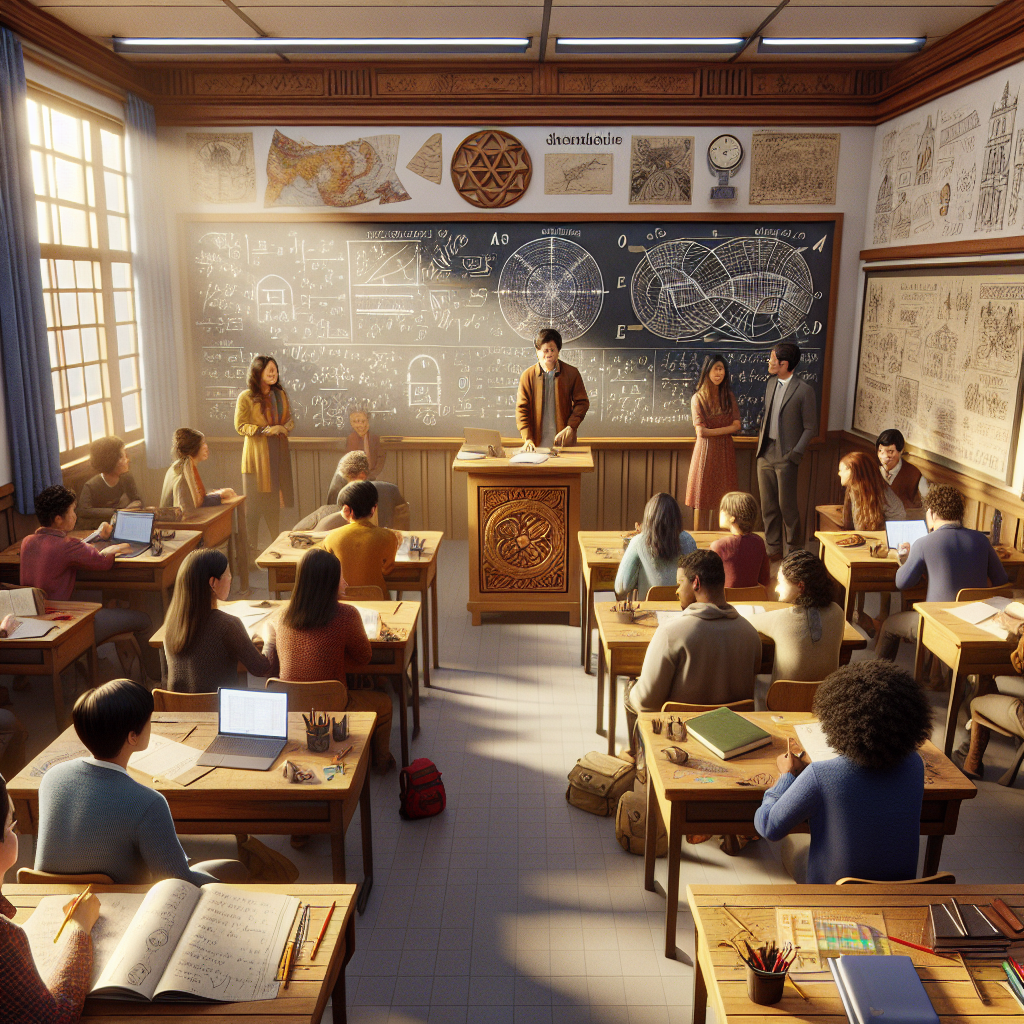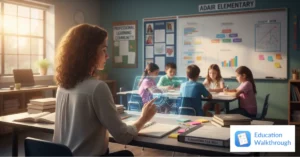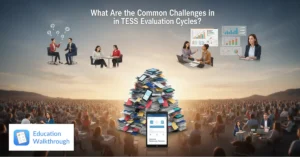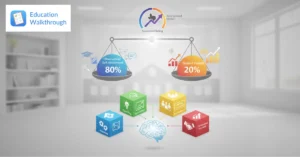General Classroom Observation Template
This template includes the basic elements of a classroom walkthrough, such as lesson objective, instructional strategies, classroom management, and student engagement.
Lesson Objective Tracking
The lesson objective is the cornerstone of any effective teaching strategy. This section of the template helps observers note whether the lesson objectives are clear, relevant, and aligned with curriculum standards. Observers can also assess if these objectives are communicated effectively to students.
Instructional Strategies Assessment
Here, the focus is on the methods and techniques the teacher uses to deliver the content. Observers can evaluate if the instructional strategies are engaging, varied, and appropriate for the subject matter and student demographics.
Classroom Management Observation
Effective classroom management is vital for a productive learning environment. This portion of the template allows observers to document how the teacher handles discipline, organizes the classroom, and facilitates transitions between activities.
Student Engagement Measurement
In this area, the observer gauges student involvement. Are students actively participating, asking questions, and showing interest in the lesson? The degree of student engagement can be a strong indicator of the lesson’s effectiveness.
Lesson Plan Alignment Template
This template focuses on aligning the observed lesson with the teacher’s lesson plan, ensuring that the objectives, activities, and assessments match.
Alignment with Curriculum
Checking for alignment with the broader curriculum is critical. This subsection helps observers determine if the lesson plan fits within the scope and sequence of the curriculum and adheres to established standards.
Consistency in Activities and Objectives
The observer notes whether the activities carried out during the class match those planned and if they effectively contribute to the lesson objectives.
Assessment and Learning Outcomes Correlation
This part of the template assesses whether the planned assessments effectively measure the stated learning outcomes, and if they are used to inform and adjust teaching practices.
Teacher Reflection Template
This template provides space for the teacher to reflect on the observed lesson and identify areas for improvement.
Self-Evaluation of Teaching Methods
Teachers can use this section to critically assess their teaching methods and the lesson’s success. Reflecting on what worked and what didn’t can lead to improved teaching strategies.
Identification of Professional Development Needs
Here, teachers can identify specific areas where they feel they need more training or resources, setting the stage for targeted professional development.
Plans for Future Lessons
In this subsection, teachers can outline how they plan to adjust future lessons based on the feedback and reflections from the walkthrough, fostering a cycle of continuous improvement.
Student Work Analysis Template
This template allows administrators to analyze student work samples to gain insight into the effectiveness of instruction.
Evaluation of Understanding
Observers can evaluate student work to determine if students have grasped key concepts and can apply them appropriately, offering a direct window into the effectiveness of the lesson.
Feedback for Improvement
This section provides a framework for giving constructive feedback to both the teacher and the student, aimed at improving future performance.
Consistency Across the Classroom
Here, the observer looks for consistency in student performance across the classroom, which can indicate the level of differentiation and equity in instruction.
Classroom Environment Template
This template focuses on the physical environment of the classroom, including organization, student work displays, and resources available for student use.
Organization and Flow
A well-organized classroom can significantly impact learning. Observers can note how the physical layout supports or hinders the flow of the lesson.
Display of Student Work
The display of student work can boost morale and create a sense of community. This section assesses how student work is showcased and whether it reflects a range of abilities and achievements.
Availability and Use of Resources
In this subsection, observers can comment on the accessibility and variety of resources available to students, including books, technology, and manipulatives.
Student Engagement Template
This template is designed to measure the level of student engagement during the observed lesson.
Behavioral Engagement
Observers can document instances of positive behavior that indicate engagement, such as on-task behavior and compliance with class rules.
Emotional Engagement
This area allows for noting signs of emotional investment in the lesson, including enthusiasm, interest, and attitudes toward the content.
Cognitive Engagement
Observers can assess the depth of student thinking and problem-solving during the lesson, noting whether students are challenged and making connections to previous knowledge.
Differentiated Instruction Template
This template focuses on how the teacher differentiates instruction to meet the needs of all students.
Adaptation for Different Ability Levels
Observers can note if and how the teacher modifies content, processes, or products to cater to students with varying levels of ability.
Response to Learning Styles
This section assesses whether the teacher incorporates different teaching styles to engage auditory, visual, and kinesthetic learners.
Tailoring to Student Interests
In this subsection, the observer can document how the teacher connects the lesson to students’ interests, potentially increasing engagement and relevance.
Assessment Data Analysis Template
This template allows administrators to analyze assessment data to determine the effectiveness of instruction and identify areas for improvement.
Analysis of Summative Assessments
Summative assessments, like tests and projects, can provide insights into student learning over a period. This section helps observers analyze this data for trends and patterns.
Formative Assessment Review
This subsection focuses on the use of formative assessments, such as quizzes and in-class activities, to gauge ongoing student understanding and inform instructional adjustments.
Data-Informed Instructional Changes
Here, observers can note how the teacher uses assessment data to make informed decisions about future instruction and intervention strategies.
Lesson Structure Template
This template focuses on the structure of the observed lesson, including a warm-up, direct instruction, guided practice, and closure.
Warm-Up Activities
The warm-up is crucial for setting the tone and activating prior knowledge. This section allows the observer to assess the effectiveness of the warm-up in preparing students for the lesson.
Direct Instruction Evaluation
In this subsection, observers evaluate the clarity, pace, and effectiveness of the direct instruction phase, where new information is typically presented.
Guided Practice Insights
Observers can note how the teacher supports students during guided practice, facilitating learning and providing feedback.
Lesson Closure
The closure is an opportunity to solidify learning. This part of the template assesses how well the lesson closure summarizes the content and reinforces key concepts.
Classroom Management Template
This template assesses the teacher’s ability to manage the classroom and maintain a positive learning environment.
Discipline and Behavior Management
Effective discipline strategies are essential for maintaining order. Observers can document the strategies used and their effectiveness in managing student behavior.
Classroom Procedures
Well-established procedures can streamline classroom operations. This section examines how procedures are communicated and followed.
Learning Environment Atmosphere
The overall atmosphere of the classroom can affect student learning. This subsection assesses the emotional climate, including the teacher’s rapport with students and the general level of respect and support.
Student-Centered Learning Template
This template measures the level of student-centered learning in the observed lesson, including student choice, collaboration, and self-directed learning.
Student Choice and Autonomy
Offering students choices in their learning can increase engagement. Observers can note the options provided to students and their impact on learning.
Collaboration Opportunities
Collaborative learning can deepen understanding. This subsection assesses the structure and effectiveness of collaborative activities.
Self-Directed Learning
Encouraging students to take charge of their learning can foster independence. Observers can document how the teacher supports self-directed learning opportunities.
Technology Integration Template
This template focuses on the use of technology in the classroom, including the type and frequency of technology use.
Technology to Enhance Learning
Observers can evaluate how technology is used to support and enhance learning, rather than just as a substitution for traditional methods.
Student Access to Technology
This subsection assesses whether all students have equitable access to the technology being used in the lesson.
Digital Literacy Skills
In this part of the template, the observer can note how the lesson contributes to students’ digital literacy skills, preparing them for future academic and professional environments.
Differentiation by Learning Style Template
This template assesses how the teacher differentiates instruction to meet the diverse learning styles of students.
Visual Learning Strategies
Observers can document the use of visual aids, such as charts and videos, and how they cater to visual learners.
Auditory Learning Strategies
This subsection focuses on strategies that benefit auditory learners, such as discussions and audio recordings.
Kinesthetic Learning Strategies
For kinesthetic learners, observers can assess the incorporation of hands-on activities and movement into the lesson.
Student Collaboration Template
This template measures the level of student collaboration during the observed lesson.
Group Work Dynamics
Observers can note the dynamics of group work, including roles, interaction, and the distribution of responsibilities.
Peer-to-Peer Learning
This section assesses how students learn from one another, whether through structured activities or informal exchanges.
Collaboration Skills Development
The observer can document how the lesson fosters the development of collaboration skills, such as communication, conflict resolution, and teamwork.
Teacher-Student Interactions Template
This template assesses the quality and frequency of teacher-student interactions during the observed lesson.
Quality of Interactions
Observers can evaluate the depth and quality of interactions, noting whether they are supportive, respectful, and geared toward advancing student learning.
Teacher Responsiveness
This subsection assesses how well the teacher responds to student questions and needs, providing timely and appropriate support.
Encouragement of Student Voice
Here, the observer can note the extent to which the teacher encourages students to express their ideas and opinions, fostering a sense of ownership and participation in the learning process.
Student-Student Interactions Template
This template focuses on the quality and frequency of student-student interactions during the observed lesson.
Peer Support
Observations can include instances of students helping and supporting each other, contributing to a collaborative learning environment.
Communication Skills
This section assesses the communication skills displayed by students during interactions, including listening, articulating thoughts, and providing constructive feedback.
Conflict Resolution
The observer can document how students handle disagreements and conflicts during collaborative activities and the role of the teacher in facilitating resolution.
Classroom Culture Template
This template measures the overall culture of the classroom, including respect, inclusivity, and positive relationships.
Respect and Inclusivity
Observers can note whether the classroom environment is respectful and inclusive, recognizing and valuing diversity among students.
Positive Relationships
This subsection assesses the strength of the relationships within the classroom, including the rapport between students and between students and the teacher.
Sense of Community
The observer can evaluate the sense of community within the classroom, looking for signs of mutual support, shared goals, and a collective responsibility for learning.
Instructional Time Template
This template assesses how instructional time is used during the observed lesson.
Time Allocation for Lesson Phases
Observers can document how time is allocated for different phases of the





